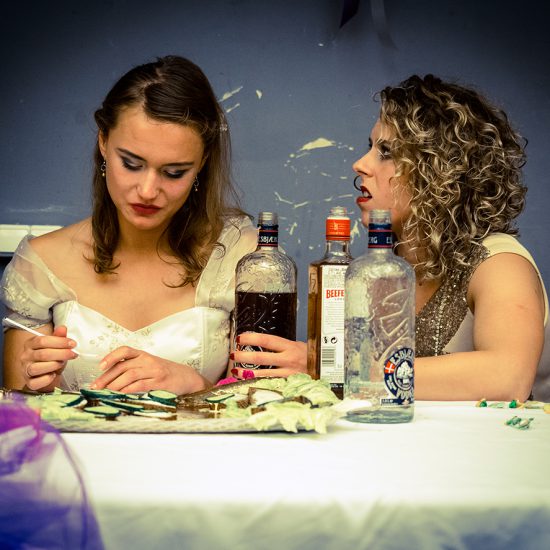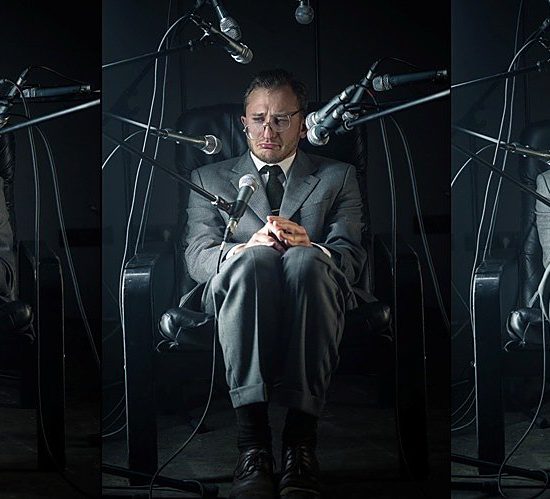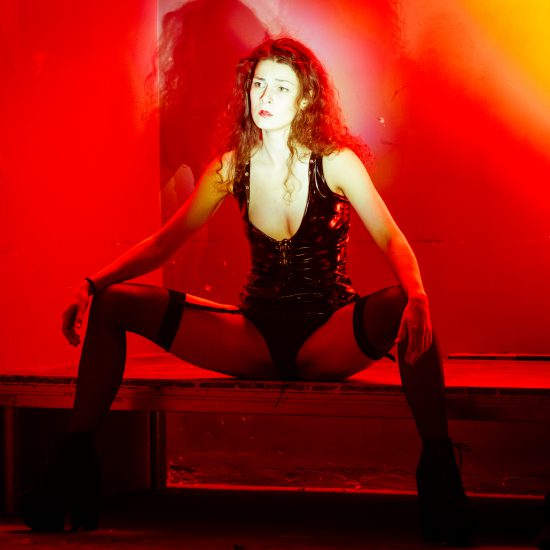“Sirenos ’13”. “New forms” OK
[…]
In The Seagull, created from nothing in the half empty OKT studio, theatre becomes life and life becomes theatre. The Seagull turned into ether vapour fills up the space to the point of explosive tension, and “the rest is silence”.
Everything is simple in the play: organic, calm intonations, logical text accents, which purify the century-old text from unnecessary pathos, casual costumes, no special requirement “to wear a jacket” (costume designer – Dovilė Gudačiauskaitė). The main building “material” and “tools” of the performance are its actors. And it looks as simple and natural as can be; after all, as corny as it may sound, The Seagull is about theatre. Not only is it a performance for the actors, it’s also based on the actors. Therefore, it is constantly evolving. There’s room for new discoveries. The bareness and simplicity of the stage requires maximum internal precision of the actors. In The Seagull, the audience and the actors become partners, observing those who are acting/living on the stage.
[…]
Quite unexpectedly, Trigorin, played by Darius Gumauskas, becomes the main antagonist (it is his eyes that glow with red devilish flame during the scene of Treplev’s play). First of all, he is lying to himself, and the writer’s mask highlighted by a pair of dark glasses is only the result. Trigorin, whose characteristics in this play make it possible to see him as the director’s alter ego, remains the main destroyer, while the young Treplev, played by Martynas Nedzinskas becomes the creator.
Young, ambitious, incredibly sensitive, perhaps even neurotic Treplev most of all suffers from an insatiable desire for love, maternal love, above all. The story line of the relationship between Nelė Savičenko’s Arkadina and Nedzinskas’ Treplev stands out in the play. The actors’ duo is well tuned and nuanced and, hence, alive, real, and painful. The impression is created not as much by the mark of the mother’s palm on Treplev’s back, as by her constantly monitoring look, disappointed or inspired by which he goes through his worst moments. Nedzinskas exploits a full range of acting skills to form his role as an ascending, yet constantly breached curve: formality is replaced with tears, and moments of emotional tension – with coldness. Emotional changes reach special density in the final scene with Zarechnaya. Zarechnaya, played by actress Gelminė Glemžaitė, who is taking her first steps on the professional stage, possesses a certain naiveté and internal purity. Beautiful, charming, sincere, emotional, she is admired by the men of The Seagull, but annoys the women.
[…]
The director, who called for new forms many years ago, from the works of the OBERIU, through classics and modernity, has reached Chekhov’s The Seagull, which, according to him, is a synthesis of all he has been moving towards for the past fifteen years. The leitmotif of the “new forms” is rather reserved in the contexts of OKT’s work and that of contemporary theatre, which is toiling in search of new forms. Contrary to those who are still searching for ways to talk about oil, which “does not succumb to the form of five acts”, Koršunovas turns his face towards something like a melodramatic four-act comedy situation.
Looking for what is real in theatre and in life he focuses on something that gets lost in today’s flow of electronic information – love. But what kind of love is killing Treplev? [ …] Treplev’s love breaks like a string. Nedzinskas’ Treplev shoots himself not because he’s disenchanted with the world and life, destroying such pure souls as Zarechnaya, but because he’s disappointed in himself, his unrecognized (either by his mother or by the critics, or, ultimately, by himself) talent and spurned love. Treplev’s love for his vision of Nina supported him not only as a person but also as a creator. It’s not the kind of love that “endures everything, believes in everything, hopes for everything, and excuses everything”; Treplev’s love was a hope for salvation, he loved an ideal rather than a creature made of flesh and blood. But in art as well as in love, ego is the main detonator.
All that suffering, passion and frustration fit into the last phrase uttered by Dorn, who was like a father figure for Treplev, “a flask of ether has exploded”. That’s all. It swelled until it finally exploded. There was a man once, but not anymore. Such is the moral “of the household”.
It is clear that the play frames the recent theatrical epic of Koršunovas, and is part of the trilogy Hamlet – The Lower Depths – The Seagull.



